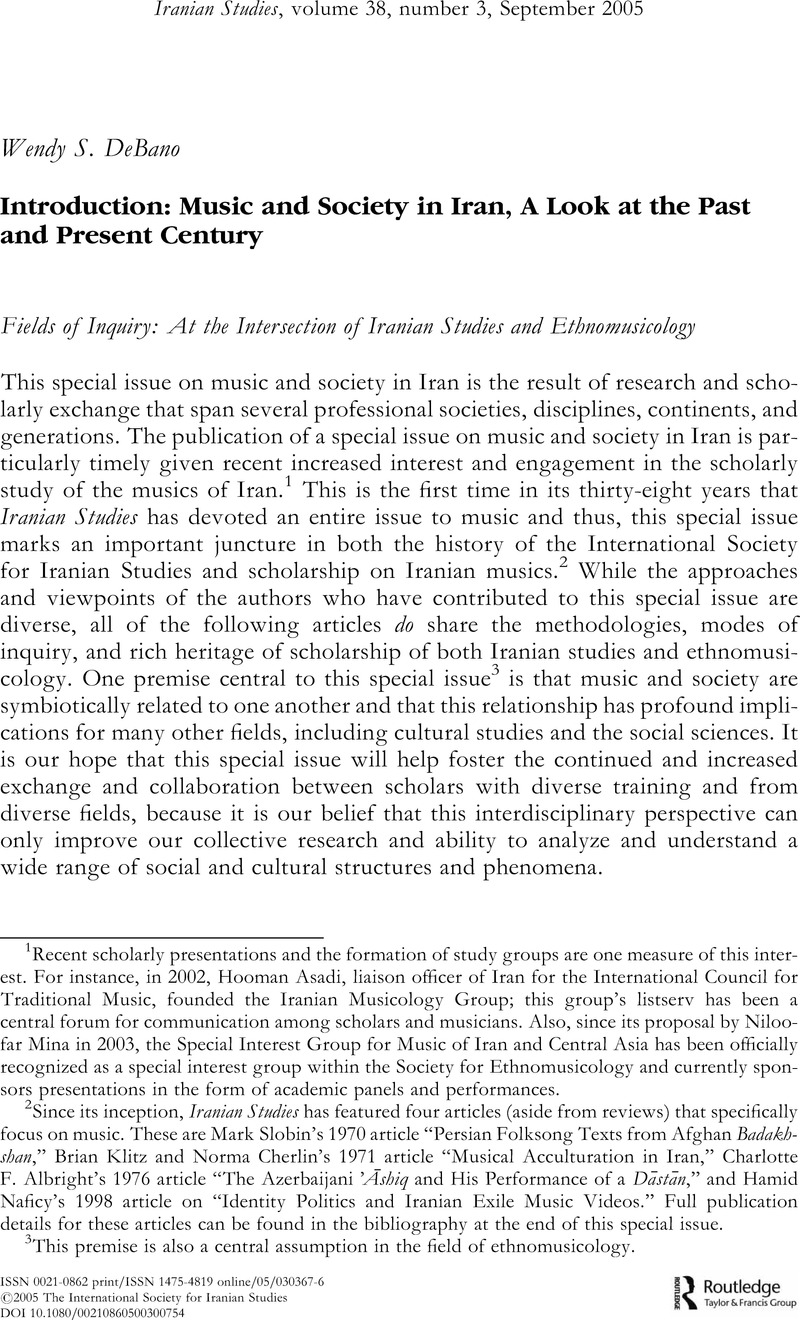No CrossRef data available.
Published online by Cambridge University Press: 01 January 2022

1 Recent scholarly presentations and the formation of study groups are one measure of this interest. For instance, in 2002, Hooman Asadi, liaison officer of Iran for the International Council for Traditional Music, founded the Iranian Musicology Group; this group's listserv has been a central forum for communication among scholars and musicians. Also, since its proposal by Niloofar Mina in 2003, the Special Interest Group for Music of Iran and Central Asia has been officially recognized as a special interest group within the Society for Ethnomusicology and currently sponsors presentations in the form of academic panels and performances.
2 Since its inception, Iranian Studies has featured four articles (aside from reviews) that specifically focus on music. These are Mark Slobin's 1970 article “Persian Folksong Texts from Afghan Badakhshan,” Brian Klitz and Norma Cherlin's 1971 article “Musical Acculturation in Iran,” Charlotte F. Albright's 1976 article “The Azerbaijani 'Āshiq and His Performance of a Dāstān,” and Hamid Naficy's 1998 article on “Identity Politics and Iranian Exile Music Videos.” Full publication details for these articles can be found in the bibliography at the end of this special issue.
3 This premise is also a central assumption in the field of ethnomusicology.
4 Many of these specialized studies are cited in the bibliography found at the end of this special issue.
5 One example of “micro” level research would be the extensive analysis of and debate about musical passages that are only seconds in length.
6 This project is still in its initial stages. By making such a list available at one site (www.musiqi.org), researchers and aficionados would be able to locate recordings and specialized written materials with much greater ease. This project has been designed so that multiple formats and forums (e.g., bibliographic materials, sound and video recordings, multimedia projects, links to relevant online resources and societies) will be included.
7 Jean During discusses this phenomenon in greater depth in this issue.
8 Exception has been for those authors, musicians, bands, and web hosts whose names (as printed in books and published online) bear an alternate form of transliteration.
9 Thus, the “ı” and “i” used the IJMES system have been changed to “i” and “e” respectively.
10 Like other scholarly publications this volume is the result of both informal and formal scholarly exchange. Although many of the contributors were already familiar with one another prior to this meeting, four of the current authors gathered together informally with other scholars of Iranian music in Tehran in 2002. It was at this and subsequent meetings and panels held by the Society for Ethnomusicology (in 2003), the Middle East Studies Association (in 2003), and the International Society for Iranian Studies (in 2004) that this issue took shape.
11 In the bibliography, readers will notice the presence of select books on Iranian dance (Shay 1999) and the music of Afghanistan (Baily 1988, Doubleday 2006, Sakata 2002, and Slobin 1976). These works have been cited because their topics are closely related to and have informed the study of musics in Iran.
12 2005 is also a significant year for the Society for Ethnomusicology; this professional society, to which almost all ethnomusicologists in North America and many in Europe belong, is celebrating its fiftieth anniversary this year.
13 Some may argue that focusing on the dawn of the third millennium (A.D.) when discussing a country where the khorshidi calendar (according to which it is currently 1384) is dominant reflects a decidedly Occidental view (Assyrian, Armenian, and other Christian communities not withstanding). Nonetheless, it is true that the past few years, which coincide with the beginning of the aforementioned millennium, have witnessed great changes in Iran's musical landscape.
14 Much like Najmabadi's approach in The Story of the Daughters of Quchan: Gender and National Memory in Iranian History (1998, New York) concepts of gender are central to Fatemi's analysis and he provides an example for musical historians interested in “writing women into the history of Iranian modernity and of writing a differently gendered history of that experience…” (Afsaneh Najmabadi, The Story of the Daughters of Quchan, 181).